Incorporating Social Studies with essay writing for elementary students can be a challenge, especially when you have a good amount of students who are English Learners or who read below grade level because odds are, they write below grade level too.
Even though teaching writing can be cognitively demanding for students, it can be taught in a way that is not only manageable for teachers but also fun for students.
If you are teaching your students about the Early English Settlements of Roanoke, Jamestown, and Plymouth, a great essay is to compare and contrast two settlements. I give my students the choice to compare Jamestown, Roanoke, and Plymouth.
Writing about these early settlements is a game-changer for combining Social Studies and ELA instruction. This Early English Settlements Compare and Contrast Report guides students step-by-step through the writing process while helping them learn about the fascinating settlements of Roanoke, Jamestown, and Plymouth. Plus, the finished essays look fantastic on bulletin boards, making it a win-win for everyone.
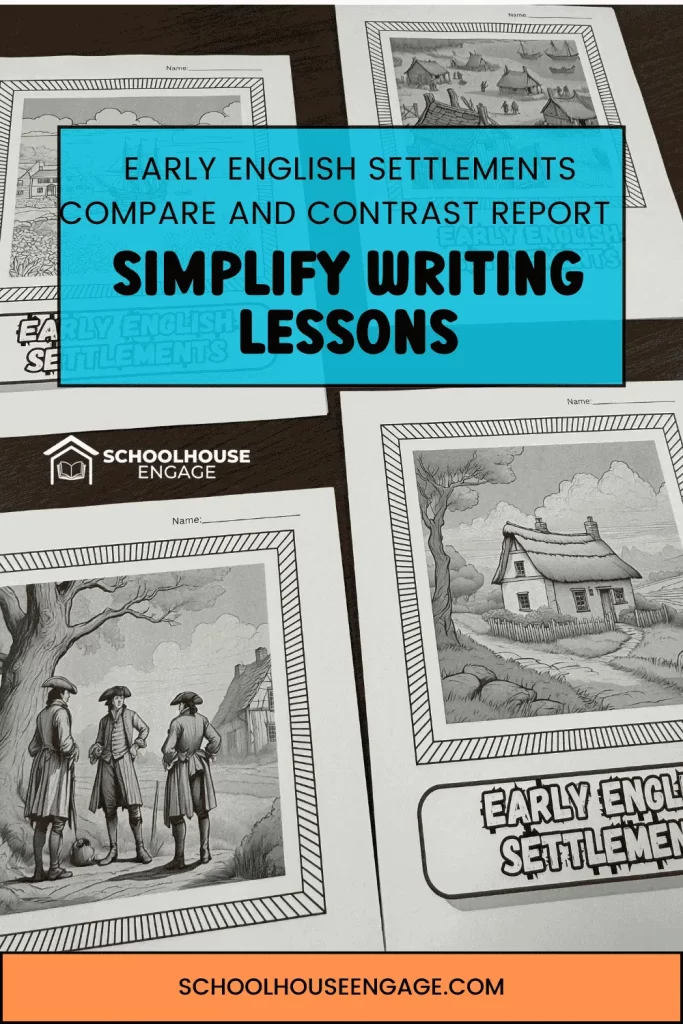
Why Use This Writing Resource?
Save Time with Ready-Made Materials
As teachers, our time is precious. That’s why I love that this resource comes with everything you need to teach essay writing effectively. From a brainstorming sheet and outlines to rubrics and example essays, the materials are designed to make your life easier. You don’t have to start from scratch—the work is already done for you.
Engage Students with Coloring an Essay Cover Page
What sets this resource apart is how it engages students. They get to color their own cover sheets for the final essay, which adds a fun and personal touch. There are 4 different coloring sheets to choose from which provides students ownership of their reports. Whether they’re writing their report by hand or typing their reports, the option to choose their coloring page makes the project fun for students.
Integrate Social Studies and ELA Seamlessly
This project doesn’t just teach writing; it also reinforces important Social Studies concepts. By comparing and contrasting Roanoke, Jamestown, and Plymouth, students gain a deeper understanding of early American history while honing their writing skills. It’s a perfect blend of integrating Social Studies into writing so students can apply what they have learned about the topic from previous presentation slides and guided notes.
Step-by-Step Lesson Plan for Success
Day 1: Analyze an Example Essay
Start by reading an example student essay comparing and contrasting Plymouth and St. Augustine, which was an early Spanish settlement.
Fun fact: St. Augustine was settled forty-two years before Jamestown.
Students will analyze the essay and annotate it by underlining the hook and background information in green, highlighting topic sentences in yellow, and circling transitions for example. This activity has many benefits including helping students understand the key components of a well-structured essay and a key is included.
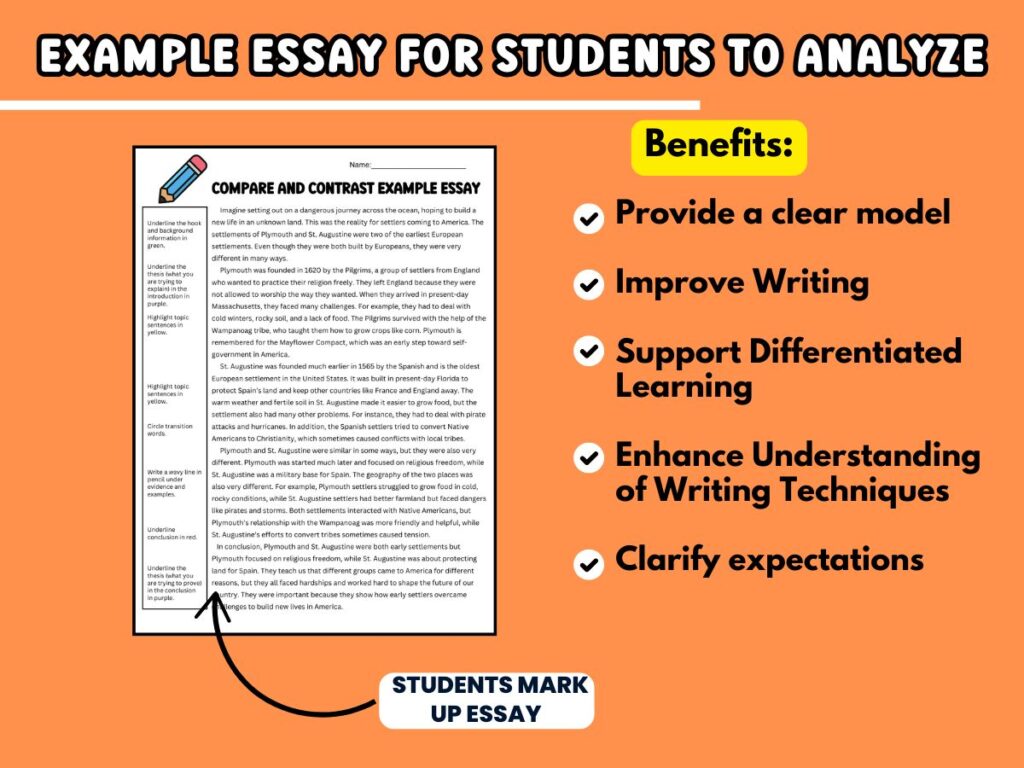
Day 2: Decide on a Topic and Brainstorm Ideas
On Day 2, decide what two colonies you will compare and contrast. As a class, we chose to do Jamestown and Roanoke. I start with a class discussion and I have my students look over their guided notes that they took previously.
After you choose a topic, guide your students through the brainstorming process. There are different ways to brainstorm but my district uses Thinking Maps so we use a graphic organizer that we call the FLEE map. It’s a combination of the flow and tree map.
It doesn’t matter what graphic organizer you choose but what is important is to remind students that they should not write any sentences.
Too often, students get carried away writing long sentences and before you know it, their brainstorming sheet is filled up with paragraphs. Then when you ask them to write a rough draft, they are burnt out.
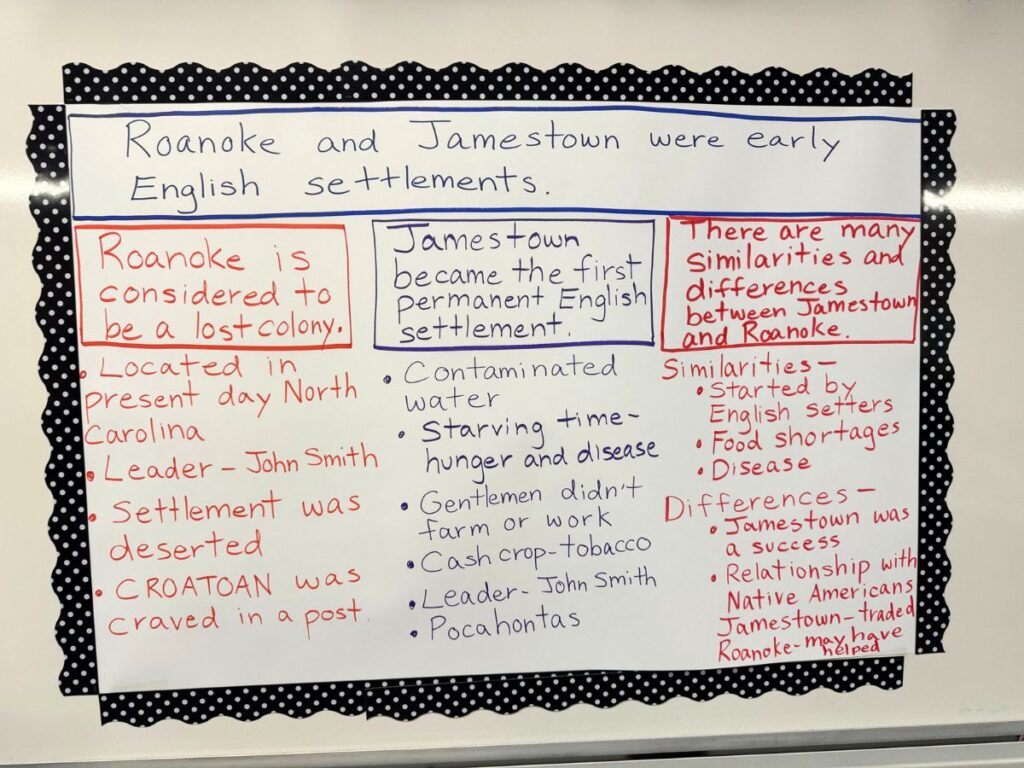
Using the graphic organizer, remind students to write words or short phrases to organize their thoughts about Roanoke and Jamestown. We do the essay topic and three body paragraph topics together. But don’t do all the work for them! Students need to do some of the work on their own.
Your students should work independently or with a partner to complete the details of the body. Allow your students to review their Social Studies books or notes to brainstorm. Once most of the class is finished, go back to the brainstorming sheet and complete it together as a class. Encourage students to add new information that they may not have.
Day 3: Begin the Essay Outline
Next, students will start their graphic organizer outline. Focus on writing an introduction that includes a hook, background information, and a thesis statement.
Have them look back at the example essay from Day 1. Get several ideas from students on how they can start their essays and write about 3 on the board. Then let students either choose from the list or come up with one on their own.
Together outline the first body paragraph by answering some of the guided questions. By breaking the essay into manageable chunks, students will have a sense of accomplishment and writing won’t feel like such a daunting task. The finished product will be something they will be proud of.
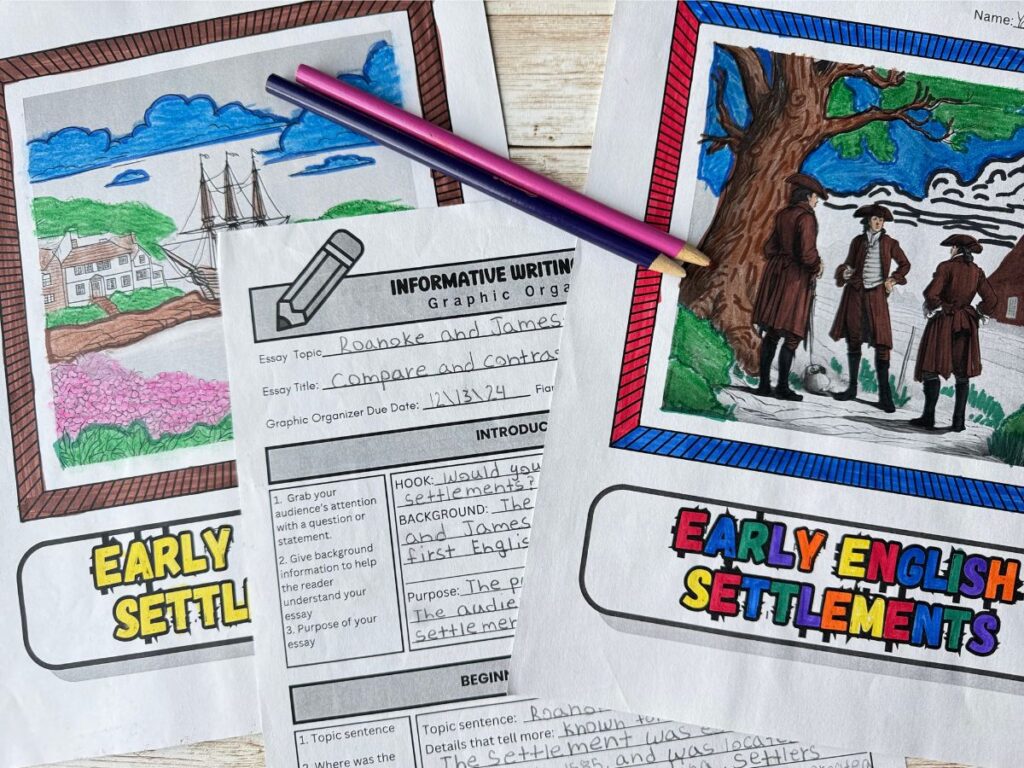
Day 4: Complete the Body Paragraphs
On Day 4, students will write the remaining body paragraphs. Encourage them to use their brainstorming sheet and outline to stay on track. This is where they’ll really show off what they have learned about the settlements, using supporting details to strengthen their points.
Day 5: Write the Conclusion and Begin Final Drafts
Teach students how to write a strong conclusion by restating the thesis in a new way and reflecting on the importance of the settlements. They’ll also answer questions like, “What lessons do these settlements teach us?” and “Why were they important?”
This is a tough one for students, so again I ask students for their ideas and we write about 3 on the board for students to choose from.
Once the conclusion in the outline is complete, students can start typing or handwrite their final drafts.
If students are typing their essays, I assign them the essay through Google Classroom. Most students prefer to type, but I do know teachers who are going back to basics by having their students actually write reports by hand.
I’ve had a few students who wrote essays that were just too good to be true. So as cumbersome as it may be for students to handwrite their essays it might be something to consider to prevent students from using AI writing tools.
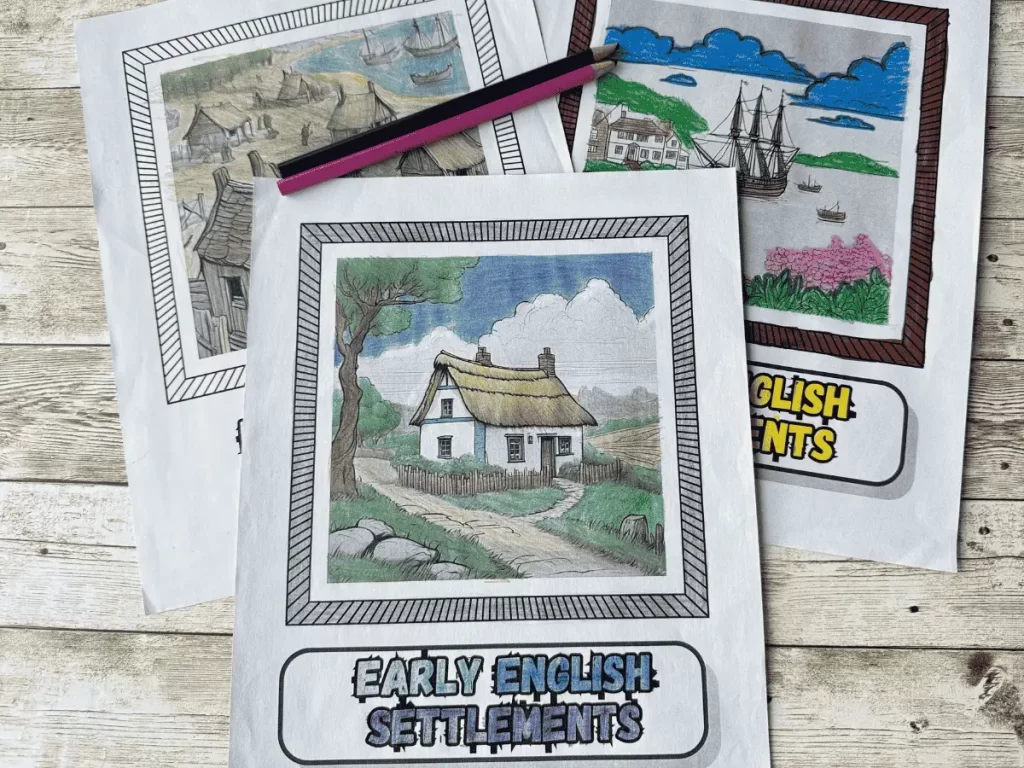
Day 6: Finish and Color Cover Page
On the final day, students will complete their reports and color their chosen cover sheets. This is where students have fun and get to make their cover sheet their own. These colorful covers are perfect for classroom bulletin boards.
What’s Included in the Resource?
Materials for Every Step of the Process
This resource truly has it all:
- Brainstorming graphic organizer (example included)
- Scaffolded outline for struggling writers
- Example essay with marking key
- Rubrics in two sizes (whole sheet and half sheet)
Creative Options for Students
Students can choose from four cover sheet designs for typed essays and four stationery designs for handwritten ones. These options let them personalize their work and take pride in the final product.
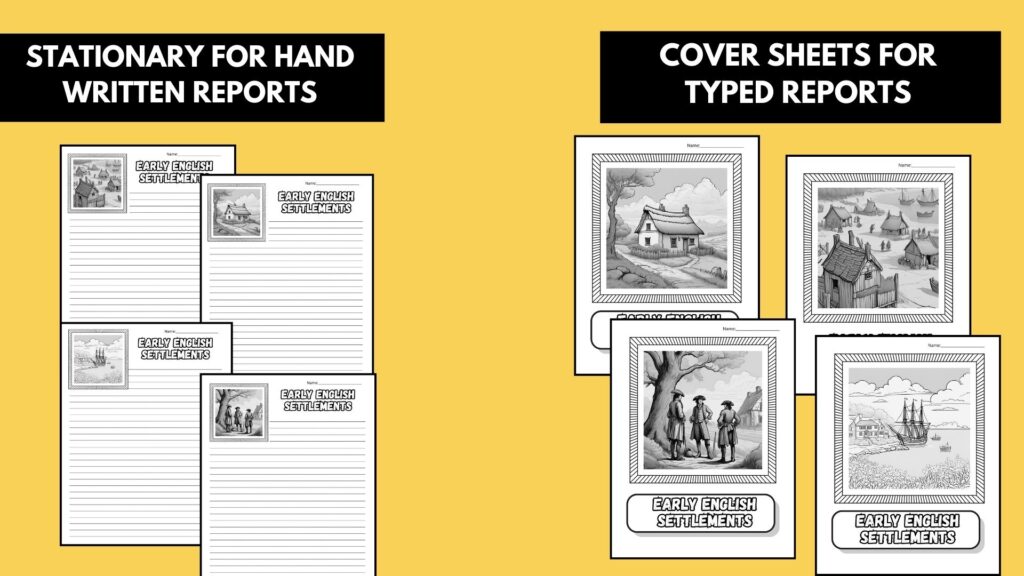
Tips for Success
Differentiate Instruction for All Learners
Not all students are ready to write independently, which is why I provide extra support for those who need it with a scaffolded outline that has sentence frames and sentence starters. This is especially important for English Learners.
This resource is designed to meet the needs of all students and comes with two types of outlines. The first outline should be used for on-grade level students or for advanced students who need a challenge. Encourage them to add more details or conduct additional research.
The scaffolded outline has fill-in-the-blank sentence frames to support English Learners or struggling writers.
For tips on how to help struggling writers, read my post about the Best Strategies for Teaching Narrative Writing to Struggling Students.
Celebrate Completed Projects
Once the essays are finished, celebrate your students’ hard work! Display their projects on a bulletin board or host a gallery walk where they can share their work with classmates. It’s a great way to build confidence and showcase their work.
Ready to Transform Your Writing Lessons?
Teaching writing doesn’t have to be stressful. With this Early English Settlements Compare and Contrast Report, you’ll have everything you need to guide your students through a meaningful and engaging project. From brainstorming to final drafts, this resource simplifies the process while integrating Social Studies and ELA seamlessly. Give it a try, and see how it transforms your writing lessons!
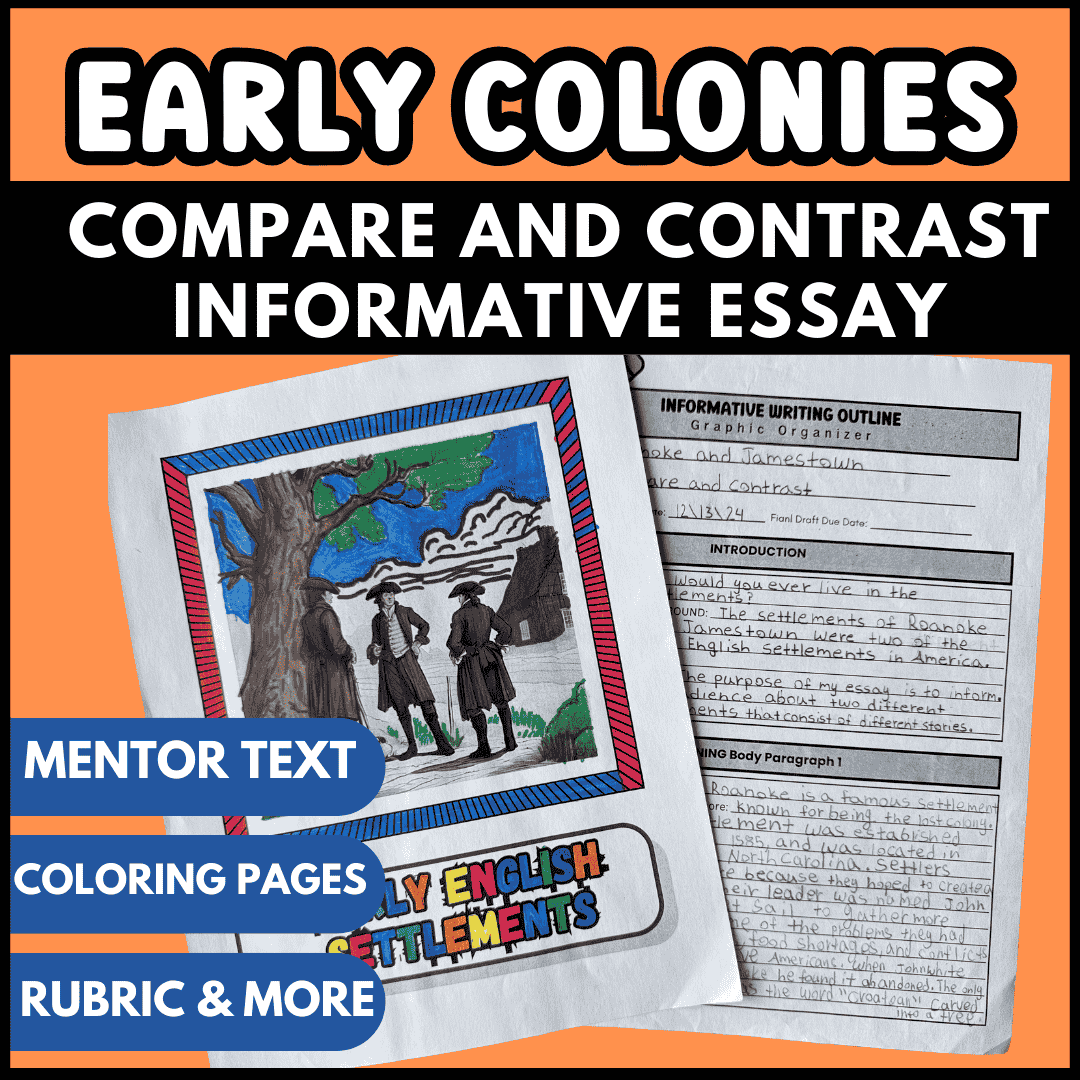
Check out the Early English Settlements Compare and Contrast Report on Teachers Pay Teachers and start making writing fun and effective in your classroom.
